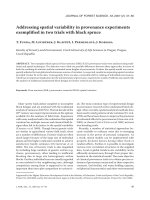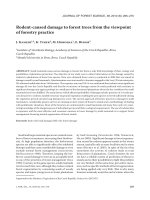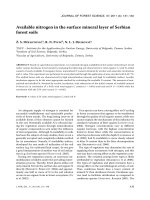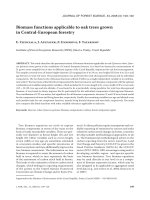Báo cáo lâm nghiệp: " Scots pine responses to number and density of inoculation points with Leptographium wingfieldii Morelet, a bark beetle-associated fungus" docx
Bạn đang xem bản rút gọn của tài liệu. Xem và tải ngay bản đầy đủ của tài liệu tại đây (709.15 KB, 10 trang )
Note
Scots
pine
responses
to
number
and
density
of
inoculation
points
with
Leptographium
wingfieldii
Morelet,
a
bark
beetle-associated
fungus
Luc Croisé
a
François
Lieutier
Erwin
Dreyer
a
a
Unité
écophysiologie
forestière,
Inra,
Centre
de
Nancy,
54280
Champenoux,
France
b
Station
de
zoologie
forestière,
Inra,
Centre
d’Orléans,
45160
Ardon,
France
(Received
8
April
1997;
accepted
21
August
1997)
Abstract -
The
effects
of
different
densities
and
total
distribution
of
inoculation
points
with
Leptographium
wingfieldii,
a
fungus
associated
with
the
bark
beetle
Tomicus
piniperda,
were
inves-
tigated
in
Scots
pine
(Pinus
sylvestris).
During
April
1993,
40
8-year-old
Scots
pine
trees
were
inoculated
into
the
trunk
and
until
the
cambium,
at
breast
height.
Inoculation
points
were
distributed
over
a
circular
belt
of
20,
40,
70
and
100
cm
width,
at
two
densities
(200
and
400
m
-2).
Three
months
after
inoculation,
the
average
length
of
the
induced
reaction
zone
was
recorded
on
the
exter-
nal
side
of
the
phloem.
The
fraction
of
sapwood
section
that
appeared
blue-stained,
desiccated
or
soaked
with
resin
was
also
measured.
The
length
of
the
visible,
induced
reaction
zone
in
the
phloem
was
affected
neither
by
inoculation
density
nor
by
width
of
the
inoculation
belt.
Similarly,
the
fraction
area
of
damaged
sapwood
was
small
and
constant
at
200
m
-2
.
It
increased
significantly
only
at
the
highest
density
(400
m
-2
)
as
a
function
of
belt
width,
reaching
70
%
at
100-cm
width.
It
is
concluded
that:
i)
the
average
length
of
the
induced
reaction
zone
in
the
phloem
is
insensi-
tive
to
inoculation
density,
and
ii)
the
importance
of
damage
in
the
sapwood
is
increasing
only
at
inoculation
densities
above
400
m
-2
over
a
sufficiently
large
area.
This
result
is
discussed
in
relation
to
the
physiological
meaning
of
the
different
symptoms,
and
in
relation
to
the
concept
of
threshold
of
attack
density
to
explain
why
pine
trees
are
affected
only
when
the
density
of bark
beetle
attacks
overrides
this
limit.
(©
Inra/Elsevier,
Paris.)
Pinus
sylvestris
/
bark
beetle
/
Leptographium
wingfieldii
/
inoculation
density
/
number
of
inoculation
points
/
phloem
/
induced
reaction
zone
/
sapwood
/
blue
staining
/
dry
sap-
wood
/
resin-soaked
sapwood
Résumé -
Réponses
du
pin
sylvestre
à
la
densité
et
au
nombre
de
points
d’inoculation
réa-
lisés
avec
Leptographium
wingfieldii
Morelet,
un
champignon
associé
aux
scolytes.
Les
effets
de
la
densité
d’inoculation
avec
Leptographium
wingfieldii
(un
champignon
associé
au
scolyte
Tomicus
piniperda)
et
de
l’augmentation
du
nombre
de
points
d’inoculation,
ont
été
étudiés
sur
*
Correspondence
and
reprints
E-mail:
le
pin
sylvestre
(Pinus
sylvestris).
En
avril
93,
quarante
pins
sylvestres
âgés
de
8
ans
ont
été
inoculés
dans
le
tronc
à
1,30
m.
Les
inoculations
étaient
réparties
sur
des
ceintures
de
20, 40,
7Q
ou
100
cm
de
largeur,
avec
deux
densités
(200
et
400
m
-2).
Trois
mois
après
inoculation,
la
lon-
gueur
des
zones
de
réaction
induites
a
été
mesurée
sur
le
côté
externe
du
liber.
Les
fractions
de
section
d’aubier
bleui,
desséché,
ou
imprégné
de
résine
ont
également
été
mesurées.
La
lon-
gueur
de
la
zone
de
réaction
visible
dans
le
liber
n’a
été
affectée
ni
par
la
densité
d’inoculation,
ni
par
la
largeur
des
ceintures
d’inoculations.
De
la
même
manière,
la
fraction
d’aubier
affectée
est
restée
faible
et
constante
à
200
inoculations
m
-2
.
En
revanche,
elle
a
augmenté
de
manière
très
importante
en
fonction
de
la
largeur
de
ceinture
d’inoculation
pour
la
densité
d’inoculation
de
400
m
-2
;
70
%
de
surface
d’aubier
étant
affecté
pour
une
ceinture
de
100
cm
de
largeur.
Deux
conclusions
sont
déduites
de
ces
résultats :
i)
la
longueur
de
la
zone
de
réaction
induite
dans
le
liber
ne
dépend
pas
de
la
densité
d’inoculation,
et
ii)
l’importance
des
dégâts
dans
l’aubier
augmente
uniquement
pour
des
densités
d’inoculations
au
dessus
de
400
m
-2
et
des
ceintures
d’inoculations
suffisamment
larges.
Ce
résultat
est
discuté
en
fonction
de
la
signification
physiologique
des
différents
symptômes,
et
en
fonction
du
concept
de
seuil
critique
de
densité
d’attaque,
pour
ten-
ter
d’expliquer
pourquoi
la
survie
des
pins
est
affectée
uniquement
quand
la
densité
d’attaques
de
scolytes
dépasse
cette
limite.
(©
Inra/Elsevier,
Paris.)
Pinus
sylvestris
/
scolyte
/
Leptographium
wingfieldii
/ densité
d’inoculations
/
nombre
d’inoc-
ulations
/ liber
/
zone
de
réaction
induite
/
aubier
/
bleuissement
/
dessèchement
d’aubier
/
imprégnation
de
résine
1.
INTRODUCTION
Bark
beetles
generally
induce
signifi-
cant
damages
only
when
their
attacks
occur
at
a
rather
high
density
on
a
single
tree.
This
fact
led
Berryman
[2]
to
define
a
threshold
of
bark
beetle
attack
density
above
which
trees
are
severely
affected
and
may
die.
Fungi
associated
with
bark
beetles
may
mimic
this
behaviour
when
inoculated
directly
into
the
trunk
[4,
17,
27,
30].
In
the
phloem,
they
induce
an
elliptical
reaction
zone
surrounding
each
point
of
attack;
heavy
accumulation
of
resin
and
secondary
metabolites
occurs
in
this
zone
that
gradually
turns
into
a
necrotic
zone
within
which
aggressors
are
confined
[2,
6,
21,
27].
In
the
sapwood,
fungi
may
promote
blue
staining
and
tissue
drying
[4,
6].
Nevertheless,
and
similar
to
that
observed
with
beetle
attacks,
inocu-
lation
with
such
fungi
has
detrimental
effects
in
the
sapwood
only
when
per-
formed
above
a
threshold
density
of
inoc-
ulation
points
[30].
When
inoculated
into
the
bole
of
Scots
pine
(Pinus
sylvestris),
the
fungus
Lep-
tographium
wingfieldii,
associated
with
the
bark
beetle
Tomicus
piniperda,
is
able
to
induce
important
reaction
zones
in
which
large
accumulations
of
monoter-
penes
[10],
resinic
acids
[19]
and
phenols
[22,
23]
occur.
The
effects
of
massive
inoculation
with
this
fungus
have
been
investigated
in
Scots
pine
by
Solheim
et
al.
[30],
who
found
that
blue
staining
occurred
in
the
sapwood
only
above
a
threshold
of
400-800
inoculation
points
m
-2
.
In
the
same
experiment,
L.
wingfieldii
killed
vigorous
Scots
pines
when
inocu-
lated
at
a
density
of
800
points
m
-2
over
a
60-cm
wide
band,
while
severely
pruned
trees
were
killed
by
an
inoculation
den-
sity
of
400
m
-2
.
In
addition
to
the
impor-
tance
of
attack
density,
it
has
been
sug-
gested
that
the
total
number
of
attacks
could
be
of
consequence
for
the
outcome
of
the
infection
in
Norway
spruce
[4,
25].
This
hypothesis
has
been
documented
by
Christiansen
and
Berryman
[5]
in
Norway
spruce,
but
no
information
was
available
until
now
for
Scots
pine.
Other
than
these
observations,
the
existence
of
a
threshold
of
inoculation
density
is
still
poorly
sup-
ported
by
experimental
evidence
in
Scots
pine.
The
present
study
aimed
at
testing
the
response
of
Scots
pine
trees
to
artificial
inoculations
with
L.
wingfieldii
as
modu-
lated
by
two
factors:
i)
density,
and
ii)
total
number
of
inoculation
points.
Results
were
expected
to
provide
approximate
val-
ues
for the
threshold
of
inoculation
density
in
the
case
of
young
Scots
pines,
and
to
allow
further
research
on
the
effect
of
environmental
factors
such
as
drought
on
Scots
pine
resistance
to
bark
beetle-asso-
ciated
fungi.
2.
MATERIALS
AND
METHODS
2.1.
Experimental
layout
During
April
1993,
40
young
Scots
pine
(Pinus
sylvestris
L.)
growing
in
the
forest
of
Orléans
(Loiret,
central
France)
were
selected
in
the
plot
n°
531
which
was
flat,
and
on
an
homogenous
soil.
They
were
8
years
old,
3.5
m
high,
and
diameter
at
breast
height
was
around
6
cm
in
all
cases.
Dead
lateral
branches
were
pruned
up
to
1.80
m,
and
the
inoculations
were
made
at
breast
height
(D
130
),
on
May
10
and
11,
under
eight
different
conditions:
two
den-
sities
of
inoculation
points
distributed
over
belts
of
four
different
widths
(table
I),
with
a
staggered
disposition
in
order
to
avoid
coales-
cence
of
the
induced
reaction
zones
in
the
phloem.
Spacing
between
inoculation
points
was
7
cm
at
200
m
-2
and
5
cm
at
400
m
-2
.
2.2.
Inoculation
of
the
fungus,
and
measurement
of
sapwood
and
phloem
reactions
L.
wingfieldii
was
collected
from
bark
bee-
tle
galleries
in
the
forest
of Orléans,
and
grown
on
a
malt
agar
medium
as
a
monospore
strain.
At
each
inoculation
point,
bark
and
phloem
were
removed
with
a
5-mm
diameter
cork
borer,
and
a
5-mm
diameter
disc
of
a
3-week-
old
malt
agar
culture
was
inserted,
with
the
fungus
side
close
to
the
sapwood.
Thereafter,
the
bark
plug
was
returned
to
maintain
the
mycelium,
and
to
avoid
contamination
[32].
Three
months
after
inoculation,
the
trees
were
felled,
and
three
stem
discs
were
cut
in
the
middle
and
close
to
both
ends
of
the
inocu-
lated
section
of
each
stem.
Areas
of blue-
stained,
dried
and
resin-soaked
sapwood
were
measured
on
the
discs
(figure
1).
Data
were
obtained
by
drawing
the
areas
on
a
transpar-
ent
paper
and
by
measuring
them
with
a
planimetre
(ΔT
area
metre,
ΔT
Devices,
Cam-
bridge,
UK).
The
outer
bark
was
removed
at
around
10
inoculation
points
in
each
tree,
and
the
visible
length
of the
induced
reaction
zones
was
measured
at
the
external
side
of
the
phloem.
2.3.
Decline
assessment
Before
felling
the
trees,
we
visually
assessed
the
degree
of
yellowing
in
the
crown,
and
ordered
them
according
to
three
classes:
1)
completely
green
needles,
2)
faint
yellowing
distributed
over
the
whole
crown
and
3)
severe
yellowing
of
the
whole
crown.
2.4.
Statistical
methods
Mean
values
of
damage
extent
were
calcu-
lated
in
each
tree,
and
resulting
values
were
compared
between
modalities.
Means
are
pre-
sented
with
their
standard
error.
Analysis
of
variance
(ANOVA)
was
achieved
using
SAS
software
(SAS
Institute,
Cary,
NC,
USA),
and
differences
between
means
were
tested
using
multiple
comparison
tests
of
Bonferroni
(α
=
0.05, n
= 5).
3. RESULTS
Three
months
after
the
inoculation
with
L.
wingfieldii,
several
trees
displayed
external
symptoms
of
decline,
with
severe
needle
yellowing;
in
particular,
trees
exposed
to
the
highest
inoculation
density
(400
m
-2
)
were
severely
affected,
while
those
inoculated
at
200
m
-2
remained
almost
unaffected
(figure
2).
The
induced
reaction
zone
surrounding
inoculation
points
in
the
phloem
was
approximately
10
cm
long;
this
length
remained
unaf-
fected
by
density
or
total
number
of
inoc-
ulation
points
(figure
3).
The
total
area
of
damaged
sapwood
increased
significantly
with
inoculation
density
and
number
of
inoculations
(figure
3).
Resin-soaked
and
desiccated
sapwood
areas
were
around
5-15
%
in
response
to
all
treatments,
and
did
not
dis-
play
any
change
with
density
or
number
of
inoculations.
The
fraction
of
blue-stained
sapwood
was
very
low
at
200
m
-2
for
all
belt
widths.
It
increased
dramatically
at
400
m
-2
for
the
highest
belt
widths
(fig-
ure
3).
In
fact,
the
interaction
between
the
two
factors
(density
and
belt
width)
was
significant
(P
>
F
0.0135):
the
increase
due
to
higher
densities
was
only
detectable
above
70
cm
belt
width.
Despite
the
lack
of
effect
of
treatments
on
the
length
of
the
induced
reaction
zone,
a
significant
correlation
between
this
parameter
and
the
damaged
sapwood
area
was
found
(table
II).
As
expected,
the
per-
cent
of
resin-soaked
and
dried
sapwood
were
correlated
as
well
as
with
the
per-
cent
total
damaged
sapwood.
4.
DISCUSSION
L.
wingfieldii
is
known
to
display
a
high
pathogenicity
and
to
have
the
capa-
bility
to
kill
Scots
pine
trees
at
least
1
year
after
inoculation
at
high
densities
[21,
29,
30].
The
effects
of
artificial
inoculation
of
a
strain
of
this
species
into
the
trunk
of
young
trees
at
two
densities
and
over
four
belt
widths
were
very
contradictory.
High-
densities
and
largest
belts
resulted
in
visible
yellowing,
but did
not
induce
tree
mortality
after
3
months.
A
similar
obser-
vation
was
previously
reported
by
Bois
[3],
who
inoculated
young
Scots
pine
at
a
high
density
(400
m
-2
)
and
on
1-m
belt
width.
In
fact,
our
observations
correspond
to
early
events
of
tree
decline,
and
the
lack
of
tree
death
after
3
months
cannot
be
used
to
affirm
that
the
density
of
inoculation
points
was
too
low
to
induce
tree
decline.
In
fact,
Solheim
et
al.
[30]
observed
tree
death
1
year
after
inoculation
at
a
density
of
400 m
-2
.
Despite
this
lack
of
mortality,
impor-
tant
damage
(i.e.
occurrence
of
large
areas
of
blue-stained,
resin-soaked
and
desic-
cated
sapwood)
was
induced
in
the
sap-
wood
and
its
extent
depended
heavily
on
the
inoculation
density.
The
highest
den-
sity
promoted
extended
damage.
Such
results
are
in
agreement
with
inoculation
density
responses
reported
for the
same
fungus-tree
model
[30].
Beyond
this
very
general
observation,
a
careful
analysis
of
symptoms
revealed
differential
effects.
Blue
staining
increased
dramatically
with
inoculation
density,
whereas
resin
soak-
ing
or
desiccation
extension
did
not
vary
significantly.
Development
of blue
stain-
ing
is
the
direct
manifestation
of
the
pres-
ence
of
the
pigmented
fungal
hyphae
[1,
11,
13]
that
preferentially
develop
in
the
ray
parenchyma
and
resin
ducts
[1,
20].
Tracheids
are
colonized
secondarily,
and
the
progress
of
the
hyphae
occurs
via
bor-
dered
pits
or
through
direct
penetration
of
the
walls
[20].
The
rate
of
fungal
colo-
nization
is
slow
in
the
nutrient-rich
ray
cells
and
faster
in
the
tracheids.
Develop-
ment
of
dried,
non-conducting
zones
in
the
sapwood
of
conifers
was
frequently
observed
in
response
to
fungal
invasion
[7,
8].
They
are
generally
located
at
the
margin
of
the stained
areas
and
elaborated
in
response
to
fungal
activity
[12, 28].
It
is
assumed
that
desiccation
of
the
sapwood
occurs
before
blue
staining,
i.e.
before
penetration
of
the
fungus
into
the
medullar
rays
[15].
In
addition,
desiccation
seems
to
be
specifically
induced
by
the
fungus;
a
simple
inoculation
with
sterile
agar
has
no
effect
[12].
Chemicals
such
as
oxalic
acid
[8]
or
others
[9,
14]
are
produced
by
several
fungi
and
may
play
a role in
induc-
ing
embolization
and
subsequent
desicca-
tion
of
sapwood
at
a
distance
from
the
zone
where
fungi
are
present.
Our
observations
fit
into
this
general
frame.
The
fact
that
desiccated
sapwood
was
relatively
stable
while
blue
staining
increased
significantly
only
above
an
inoc-
ulation
density
of
400
m
-2
with
a
width
of
70
cm
suggests
that
generalized
colo-
nization
of
sapwood
probably
occurs
only
above
a
severe
inoculum
constraint.
We
may
hypothesize
that
the
progression
of
L.
wingfieldii
in
the
sapwood
is
accompa-
nied
by
a
gradual
desiccation
of
wood
tis-
sues
that
are
secondarily
invaded
by
mycelia.
As
such,
we
may
state
that
a
threshold
of
inoculation
density
must
be
reached
before
the
invasion
of
the
sap-
wood
by
mycelial
strains
is
possible.
The
sequence
of
events
leading
to
the
infec-
tion
stage
observed
in
our
stem
sections
needs,
nevertheless,
to
be
better
docu-
mented
by
sequential
anatomical
obser-
vations
during
the
course
of
infection.
The
impact
of
the
total
number
of
inoc-
ulation
points
at
a
given
density
has
been
suggested
by
Christiansen
[4],
Mulock
and
Christiansen
[25]
and
Homtvedt
and
Solheim
[16].
More
recently,
Christiansen
and
Berryman
[5]
observed
that
the
blue-
stained
sapwood
cross-sectional
area
was
dependent
on
the
inoculated
belt
width
in
Norway
spruce.
They
evidenced
that
at
an
inoculation
density
of
400
m
-2
with
Cer-
atocystis
polonica,
blue
staining
was
greatly
enhanced
as
soon
as
the
belt
width
overcame
50
cm
in
a
susceptible
clone,
while
in
two
resistant
ones,
a
width
above
90
cm
was
needed
to
obtain
similar
dam-
age.
Our
results
clearly
confirm
the
impor-
tance
of
the
total
number
of
inoculation
points,
as
a
large
increase
of
blue
stain-
ing
was
observed
in
the
sapwood
with
an
increasing
amount
of
inoculation
points,
at
a
density
of
400
m
-2
.
Nevertheless,
we
also
showed
that
this
response
depended
on
inoculation
density
and
was
not
detected
at
a
lower
density
of
200
m
-2
.
Finally,
our
experiment
suggests
that
the
threshold
of
inoculation
density
with
L.
wingfieldii
is
close
to
400
m
-2
on
a
belt
width
of
100
cm.
Above
such
conditions,
death
of
young
Scots
pines
may
be
expected.
This
value
is
close
to
the
thresh-
old
of
600
m
-2
over
a
60-cm
belt
width
shown
by
Solheim
et
al.
[30]
with
the
same
species
but
somewhat
older
and
taller
trees
(20
years,
5.5
m).
In
the
same
way,
the
critical
threshold
of
inoculation
density
probably
depends
on
tree
vigour.
For
instance,
Långström
et
al.
[18]
showed
that
pruned
Scots
pine
were
more
heav-
ily
affected
by
bark
beetle
(Tomicus
piniperda)
attacks
than
unpruned
ones.
Mahoney
[24],
Raffa
and
Berryman
[27],
and
Waring
and
Pitman
[31]
observed
that
Pinus
contorta
trees
with
a
low
sapwood
productivity
were
more
sensitive
to
Den-
droctonus
ponderosae
attacks
than
trees
with
a
high
sapwood
productivity.
Similar
results
were
obtained
with
Picea
abies
attacked
by
Ips
typographus
[25].
Using
the
technique
of
mass
inoculation
with
Ceratocystis
polonica,
Christiansen
[4]
showed
that
suppressed
trees
appeared
more
susceptible
than
more
vigorous
trees.
It
is
therefore
extremely
difficult
to
extrap-
olate
our
results
to
other
stands
of
Scots
pine
without
additional
information
on
the
relationships
between
growth
conditions,
tree
vigour
and
susceptibility
to
L.
wing-
fieldii.
A
last
but
interesting
result
of
our
study
lies
in
the
stability
of
the
length
of
the
induced
reaction
zone
in
the
phloem,
which
was
significantly
affected
neither
by
the
density
nor
by
the
total
amount
of
inoculation
points.
This
observation
is
similar
to
those
made
by
Solheim
et
al.
[30]
and
by
Bois
[3].
It
points
to
a
rela-
tive
independence
between
the
responses
observed
in
the
phloem
and
the
spread
of
the
fungus
in
the
sapwood.
The
slight
cor-
relation
found
between
this
parameter
and
the
total
damage
in
the
sapwood
tempers
this
assertion.
ACKNOWLEDGEMENTS
The
authors
are
grateful
to
the
’Office
National
des
Forêts’
for
providing
the
Scots
pine
stand
in
the
forest
of
Orléans,
and
the
technical
help
of
J.
Garcia
and
P.
Romary
is
acknowledged.
We
thank
C.
Delatour
for
improving
our
initial
manuscript,
and
two
anonymous
referees
for
helpful
comments.
REFERENCES
[1]
Ballard
R.G.,
Walsh
M.A.,
Cole
W.E.,
The
penetration
and
growth
of
blue-stain
fungi
in
the
sapwood
of
lodgepole
pine
attacked
by
mountain
pine
beetle,
Can.
J.
Bot.
62
(1984)
1724-1729.
[2]
Berryman
A.A.,
Biological
control,
thresholds,
and
pest
outbreaks,
Environ.
Entomol. 11
(1982) 544-549.
[3]
Bois
E.,
Rôle
des
composés
phénoliques
dans
la
résistance
du
Pin
sylvestre
aux
attaques
de
Scolytidae
et
de
leurs
champignons
associés
Ph.D.
thesis,
University
of
Orléans,
France,
1996, 136
p.
[4]
Christiansen
E.,
Ceratocystis polonica
inocu-
lated
in
Norway
spruce:
blue-staining
in
relation
to
inoculum
density,
resinosis
and
tree
growth,
Eur.
J.
For.
Pathol.
15
(1985)
160-167.
[5]
Christiansen
E.,
Berryman
A.A.,
Norway
spruce
clones
vary
widely
in
their
susceptibil-
ity
to
a
bark
beetle-transmitted
blue-stain
fun-
gus,
in:
Hain
F.P.,
Salom
S.M.,
Ravlin
W.F.,
Payne
T.L.,
Raffa
K.F.
(Eds.),
Behavior,
Pop-
ulation
Dynamics
and
Control
of
Forest
Insects,
Proceedings
of
the
International
Union
of
Forestry
Research
Organizations,
working
party
S2,
07-06
Maui,
Hawaii,
February
1994,
Ohio
State
University
Press,
Columbus,
1995.
[6]
Christiansen
E.,
Waring
R.H.,
Berryman
A.A.,
Resistance
of
conifers
to
bark
beetle
attack:
searching
for
general
relationships,
For.
Ecol.
Manag.
22
(1987)
89-106.
[7]
Coutts
M.P.,
The
formation
of
dry
zones
in
the
sapwood
of
conifers.
I.
Induction
of
drying
in
standing
trees
and
logs
by
Fomes
annosus
and
extracts
of
infected
wood,
Eur.
J.
For.
Pathol.
6
(1976) 372-381.
[8]
Coutts
M.P.,
The
formation
of
dry
zones
in
the
sapwood
of
conifers.
II.
The
role
of
living
cells
in
the release
of
water,
Eur.
J.
For. Pathol. 7
(1977) 6-12.
[9]
DeAngelis
J.D.,
Hodges
J.D.,
Nebeker
T.E.,
Phenolic
metabolites
of
Ceratocystis
minor
from
laboratory
cultures
and
their
effects
on
transpiration
in
loblolly
pine
seedlings,
Can.
J.
Bot.
64
(1986)
151-155.
[10]
Delorme
L.,
Lieutier
F.,
Monoterpene
compo-
sition
of
the
preformed
and
induced
resins
of
Scots
pine,
and
their
effect
on
bark
beetles
and
associated
fungi,
Eur.
J.
For.
Pathol.
20
(1990)
304-316.
[11]
Gibbs
J.N.,
The
biology
of
Ophiostomatoid
fungi
causing
sapstain
in
trees
and
freshly
cut
logs,
in:
Wingfield
M.,
Seifert
K.A.,
Weber
J.F.
(Eds.),
Ceratocystis
and
Ophiostoma,
Tax-
onomy,
Ecology
and
Pathogenicity,
The
Amer-
ican
Phytopathological
Society,
St.
Paul,
Min-
nesota
(17)
1993,
pp.
153-160.
[12]
Harding
S.,
The
influence
of
mutualistic
blue
stain
fungi
on
bark
beetle
population
dynamics,
Ph.D.
thesis,
University
of
Copehagen,
Den-
mark,
1989, 163
p.
[13]
Hartig
R.,
Die
Zersetzungsercheinungen
des
Holzes
der
Nadelbaüme
und
der
Eiche,
Julius
Springer,
Berlin,
1878,
151
p.
[14]
Hemingway
W.,
McGraw
G.,
Barras
S.J.,
Polyphenols
in
Ceratocystis
minor
infected
Pinus
taeda:
fungal
metabolites,
phloem
and
xylem
phenols,
J.
Agric.
Food
Chem.
24
(1977)
717-722.
[15]
Hobson
K.R.,
Parmeter J.R.,
Wood
D.L.,
The
role
of
fungi
vectored
by
Dendroctonus
brevi-
comis
Leconte
(Coleoptera:
Scolytidae)
in
occlusion
of
ponderosa
pine
xylem,
Can.
Ento-
mol.
126 (1994) 277-282.
[16]
Horntvedt
R.,
Solheim
H.,
Pathogenicity
of
Ophiostoma
polonicum
to
Norway
spruce:
the
effect
of isolate
age
and
inoculum
dose,
Medd.
Norsk.
Inst.
Skogforsk.
44
(1991)
1-11.
[17]
Horntvedt
R.,
Christiansen
E.,
Solheim
H.,
Wang
S.,
Artificial
inoculation
with
Ips
typographus-associated
blue-stain
fungi
can
kill
healthy
Norway
spruce
trees,
Medd.
Norsk.
Inst.
Skogforsk.
38
(1983)
1-20.
[18]
Långström
B.,
Hellqvist
C.,
Ericsson
A.,
Gref
R., Induced
defence
reaction
in
Scots
pine
fol-
lowing
stem
attacks
by
Tomicus
piniperda,
Ecography
15
(1992)
318-327.
[19]
Långström
B.,
Solheim
H.,
Hellqvist
C.,
Gref
R.,
Effects
of
pruning
young
Scots
pines
on
host
vigour
and
susceptibility
to
Leptographium
wingfieldii
and
Ophiostoma
minus,
two
blue-
stain
fungi
associated
with
Tomicus
piniperda,
Eur.
J.
For.
Pathol.
23
(1993)
400-415.
[20]
Liese
W.,
Schmid
R.,
Licht
und
elektronen-
mikroskopische
Untersuchung
über
das
Wach-
stum
von
Bläuepiltzen
in
Kiefern
und
Ficht-
enholz,
Holz
Roh.
Werkst.
9
(1961)
329-337.
[21]
Lieutier
F.,
Cheniclet
C.,
Garcia
J.,
Comparison
of
the
defence
reactions
of
Pinus
pinaster
and
Pinus
sylvestris
to
attacks
by
two
Bark
beetles
(Coleoptera :
Scolytidae)
and
their
associated
fungi,
Environ.
Entomol.
18
(1989)
228-234.
[22]
Lieutier
F.,
Yart
A.,
Jay-Allemand
C.,
Delorme
L.,
Preliminary
investigations
on
phenolics
as
a
response
of
Scots
pine
phloem
to
attacks
by
bark
beetles
and
their
associated
fungi,
Eur.
J.
For.
Pathol.
21
(1991)
354-364.
[23]
Lieutier
F.,
Sauvard
D.,
Brignolas
F.,
Picron
V.,
Yart
A.,
Bastien
C.,
Jay-Allemand
C.,
Changes
in
phenolic
metabolites
of Scots-pine
phloem
induced
by
Ophiostoma
brunneo-cil-
iatum,
a
bark-beetle-associated
fungus,
Eur.
J.
For.
Pathol.
26
(1996)
145-158.
[24]
Mahoney
R.L.,
Lodgepole
pine/mountain
pine
beetle
risk
classification
methods
and
their
application, in:
Berryman
A.A.,
Amman
G.D.,
Stark
R.W.,
Kibbee
D.L.
(Eds.),
Theory
and
Practice
of
Mountain
Pine
Beetle
Management
in
Lodgepole
Pine
Forests,
College
of
Forest
Resource,
Univ.
of Idaho,
Moscow,
1978,
pp.
106-113.
[25]
Mulock
P.,
Christiansen
E.,
The
threshold
of
successful
attack
by
Ips
typographus
on
Picea
abies:
a
field
experiment,
For.
Ecol.
Manag.
14 (1986) 125-132.
[26]
Raffa
K.F.,
Berryman
A.A.,
Physiological
dif-
ferences
between
lodgepole
pines
resistant
and
susceptible
to
the
mountain
pine
beetle
and
associated
microorganisms,
Environ.
Entomol.
11
(1982) 486-492.
[27]
Raffa
K.F.,
Berryman
A.A.,
Physiological
aspects
of lodgepole pine
wound
responses
to
a
fungal
symbiont
of
the
mountain
pine
bee-
tle,
Dendroctonus
ponderosae
(Coleoptera:
Scolytidae),
Can.
Entomol.
115
(1983)
723-734.
[28]
Shain
L.,
The
response
of
sapwood
of
Norway
spruce
to
infection
by
Fomes
annosus,
Phy-
topathology
61
(1971)
301-307.
[29]
Solheim
H.,
Långström
B.,
Blue-stain
fungi
associated
with
Tomicus
piniperda
in
Sweden
and preliminary
observations
on
their
pathogenicity,
Ann.
Sci.
For.
48
(1991)
149-156.
[30]
Solheim
H.,
Långström
B.,
Hellqvist
C.,
Pathogenicity
of
the
blue-stain
fungi
Lep-
tographium
wingfieldii
and
Ophiostoma
minus
to
Scots
pine:
effect
of tree
pruning
and
inocu-
lum
density,
Can.
J.
For.
Res.
23
(1993)
1438-1443.
[31]
Waring
R.H.,
Pitman
G.B.,
Physiological
stress
in
lodgepole
pine
as
a
precursor
for
mountain
pine
beetle
attack,
Z.
Angew.
Entomol.
96
(1983) 265-270.
[32]
Wright
E.,
A
cork-borer
method
for inoculating
trees,
Phytopathology
23
(1933)
487-488.









